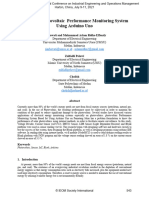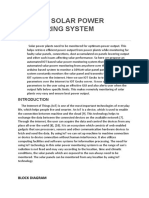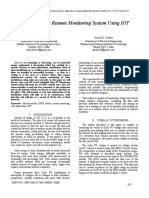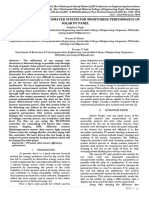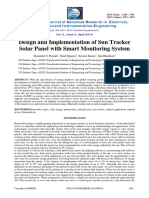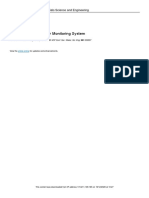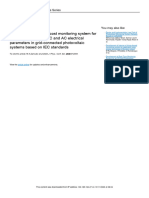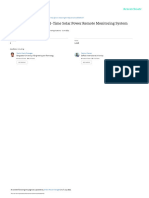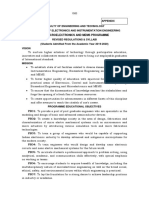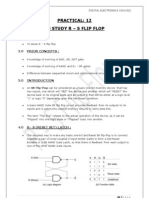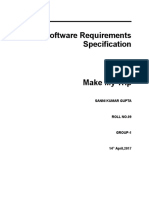Real Time Performance Monitoring Of Solar Panel
Turkish Online Journal of Qualitative Inquiry (TOJQI)
Volume 6, July 2021 : 5843 - 5854
Research Article
Real Time Performance Monitoring Of Solar Panel
Alexander Jeevanandham Ya, Govind K b, Jeevaharan M J c, Kamalesh M d, Natarajan Ve
a
Assistant Professor, Department of EEE, RMK Engineering College, Chennai, ajm.eee@rmkec.ac.in
b,c,d,e
UG Scholars, Department of EEE, RMK Engineering College, Chennai
Abstract
With the depletion of fossil fuels and increase in Power usage, People started using Renewable Energy resources
particularly Solar energy in tropical countries like India. But most of the customers still have difficulties
interpreting conventional energy meters. In most of the existing systems, solar panel monitoring is done by a
current sensor, voltage sensor, raspberry-pi, wi-fi module, and the output is shown using 3rd party applications
which costs more and have security issues. Hence we have created a system using photovoltaic cell, Arduino
UNO, Ina219, and the output is shown on our own website using Nodejs and MongoDB where both the
customer and service provider has access to the data in a more understandable way. These data will be computed
and an automated mail will be triggered in case the panel needs maintenance
Keywords: Solar power, performance monitoring, Ina219 sensor, Website using Nodejs MongoDB
1. Introduction
In our modern world, the usage of electricity keeps on increasing while conventional resources keep on
depleting. Renewable energy resources seem a promisable alternative resource for our current scenario. While
there are different types of renewable energy resources available, tropical countries like India which receives
more solar radiation than other subtropical countries focuses majorly on solar energy.
Of the total renewable energy harnessed the solar power harnessed is nearly 40.4% (36,050.74MW of total
89,229.42 MW)[1][2] as of March 2020.
Solar power is one among the fastest developing industries in India. The solar installed capacity of the
country was 36.9GW as of 30 November 2020.[3] In the year 2015, Over 118700 solar systems were used to
light homes and in the same year 46555 street lights were powered by solar panels which were contributed by
the National Program.[4]
Amidst the significance of solar panels, we should also consider that nearly 4.4% of energy is lost per panel
on a daily basis due to the accumulation of dust and inadequate maintenance services.[5] Which greatly
decreases the efficiency of solar panel.
The authors Gusa et al. proposed a system for monitoring the PV panel in their paper “Monitoring System
for Solar Panel Using Smartphone Based on Microcontroller” in 2nd International Conference on Green Energy
and Applications (2018). [6] The system uses the Atmega 2560 which can sense temperature, current and
voltage with the help of sensors. The system is connected to the smartphone via ESP module. It displays the
parameters like voltage, temperature and current of PV panel using Blynk mobile application.
The above mentioned system uses third-party applications such as the Blynk app which may lead to security
issues due to the involvement of third-party applications and very limited data can be viewed through the app.
Usage of a wide range of sensors makes the system costlier as an end product.
5843
� Alexander Jeevanandham Y, Govind K, Jeevaharan M J, Kamalesh M, Natarajan V
The authors Aziz Oukennou et al. [2019] Proposed a monitoring system for the PV panel in their paper
“Low Cost IoT System for Solar Panel Power Monitoring” in Institute Universitaire de Technologie [7].This
system uses Node MCU by connecting it with Node-Red. This system can help to measure the PV system’s
productions such as voltage, current, and power.
The above mentioned system uses Node-Red which can be used only on a local machine. This leads to the
disadvantage that it can be viewed only with the computer that is connected to the local LAN, unlike websites it
cannot be viewed remotely from any other places. The system can only display sensor data but cannot perform
any calculations.
Apart from that generally the customers who use solar panels in their homes still have a lot of difficulties in
interpreting the data from conventional energy meters. This leads them to depend on the technician’s words in
case of the system is connected on grid. Even though there are certain ideas developed to monitor the PV
panel’s parameters they were both costly and use third-party applications to show their end output which has its
limitations and can lead to security issues.
Thus the main objective of our project is that the data from the solar panel can be accessed and viewed both
by the customer and the service provider via the website from anywhere in the world with utmost security. The
data consists of the power generated from the panel and money saved by using the solar panel. The data is
represented as a graph for easy understanding and an email is triggered automatically if the panel requires
maintenance.
2. Components Required
2.1 Hardware:
1. Solar Panel
2. Arduino UNO
3. Charge controller
4. INA219
5. Battery
6. Load
2.2 Software:
1. Arduino IDE
2. NodeJS
3. ExpressJS
4. MongoDB
5. HTML, CSS, JavaScript
2.3 Components Description
The description and rating mentioned below is based on our prototype it may subject to variation based on
where we implement the system.
i. Solar Panel
A PV panel is an array of semiconductors called as photovoltaic cells which harness solar energy from the
sunlight and convert it into DC output.
5844
� Real Time Performance Monitoring Of Solar Panel
Fig 1: Solar Panel
Based on the intensity of solar radiation the output current will vary. To obtain a constant stable output a
charged controller is connected between the solar panel and the load.
For our prototype, we have used a panel with a maximum current of 1.17A and maximum voltage of 17V
where the panel’s maximum power is 20W.
ii. Arduino Uno
Arduino UNO is board which is embedded with Atmega 328P microcontroller.[17] It communicates with the
PC via the USB cable which powers the board and also helps to transfer data from the Arduino board. In our
prototype we are using analog pins to transfer data from the sensor to the board.
Fig 2: Arduino UNO
iii. Charge controller
A charge controller reduces the rate at which current that is stored to or discharged from battery. It has 6 pins
of which 3 for positive terminal and 3 for negative terminals to which the solar panel battery and the load is
connected.
It protects the battery from draining fully ("deep discharging"), or discharges at controlled rates depending
on the battery composition, to protect battery life.
For our prototype we have used a charge controller which is having a rated voltage of 12-24 volts and 10
amps as its current rating.
5845
� Alexander Jeevanandham Y, Govind K, Jeevaharan M J, Kamalesh M, Natarajan V
Fig 3: Solar Panel charge controller
iv.INA219
INA219 is a sensor which acts as a digital replacement of conventional ammeter, voltmeter and wattmeter as
it measures power, current and voltage. It is a sensor which can take only Direct Current as input. It is a sensor
with high accuracy to measure only low DC current upto 3.2 Amps.
It has 8 pins of which Vcc of the sensor is connected to pin 5V in Arduino and the ground of sensor with
ground of Arduino. Scl and Sda of the sensor to A5 and A4 of Arduino Board. So that the sensor data will be
exchanged to Arduino in the analog pin A4.
For our prototype we have used an INA219 sensor which is having a voltage range of 26 volts and 1 milli
amp as its current rating. The operating voltage of this sensor is 3 to 5.5 volts.
Fig 4: INA219 Current Sensor
v. BATTERY
A battery is an electrical device which is used to store energy by converting electrical energy to chemical
energy and discharge it by reversing the process.
In most off-grid systems the battery is connected to the solar panel to store the excess power generated by
the solar panel so that it can be used at a later period of time.
The battery is considered as a load in case of charging and as a source while discharging. The battery is
usually connected after the charge controller as varying current and voltage may affect the lifetime of the
battery.
For our prototype we have chosen a battery which is having a standby voltage of 13.5-13.8 volts and with
13.5 amps as its current rating. The composition of the cell is scaled lead acid battery.
5846
� Real Time Performance Monitoring Of Solar Panel
Fig 5: Amptek 12v 4.5Ah SMF/VRLA Battery
vi. LOAD
The load can be any device that consumes power, for our prototype we have used a DC bulb as a load.
Fig 6: DC Bulb
vii. ARDUINO IDE
Arduino IDE is software developed by Arduino to interact with various types of Arduino boards. It is
compile and dumped into the microcontroller’s memory embedded in the Arduino board as many times as
possible.
It has serial monitor which acts as an interface to view the data transferred by the Arduino board. It has
many inbuilt libraries such as Adafruit INA219 which is used in our project.
Fig 7: Arduino IDE
5847
� Alexander Jeevanandham Y, Govind K, Jeevaharan M J, Kamalesh M, Natarajan V
3. Flowchart
The INA219 sensor can measure voltage, current, and power. It is connected to the solar panel. Arduino will
receive the data sensed by the sensor. The serial port which is a node package manager is capable of receiving
the data which arduino receives through a port. This obtained data is saved to the cloud database with the help of
mongoose.
With the help of weather api, the current temperature of the location is obtained and later it is used to check
the panel condition.
Later, the data which is saved in the database is collected using the backend with the help of NodeJS and it is
displayed in a graph format. The obtained power is analysed to check the panel condition.
If power obtained today is less than the last two day’s power and also the weather for that day is good then it
is concluded that the panel needs maintenance and a mail is sent to the customer. If today’s power is more or
less the same as yesterday’s then no mail is sent and website will show that the panel is in good condition.
The website also shows us the panel specifications and also the weather data from the weather API.
Fig 8: Flowchart
5848
� Real Time Performance Monitoring Of Solar Panel
4. Proposed System
The system consists of a 20W Solar panel that has been connected to the charge controller as the output of
the solar panel varies with respect to the change in solar radiation.
The device connected as the load is designed to have constant voltage and current. If the voltage or current
varies rapidly for a long time it may affect the load and might decrease the life span of the load. The charge
controller will convert the variable voltage or current input to a constant DC output thus protecting the load and
battery. The load we have connected here is a DC Bulb.
The battery is connected with the charge controller in parallel to the load. In case if the load is disconnected
from the circuit the power generated from the solar panel will be stored in the battery without being wasted.
If the load demands more power than that is generated the battery acts as an energy source by discharging
the current that it has already stored. The battery can also be damaged by the varying output of the solar panel in
order to prevent so it has been connected to the charge controller.
Fig 9: Prototype of the proposed system
The Ina219 sensor will measure voltage, current, and power. The sensor is placed between the charge
controller and the PV panel. The positive terminal of the
10 : Block Diagram
sensor is connected to positive terminal of the PV panel and the negative terminal of sensor is connected to
the positive terminal of load. The negative terminal of the solar panel is connected to the negative terminal of
load.
The Vcc of the sensor is linked to pin 5V in Arduino and the ground of sensor with ground of Arduino. Scl
and Sda of the sensor to A5 and A4 of Arduino. The negative of the solar panel is linked to ground pin 14 of the
Arduino. The Arduino
5849
� Alexander Jeevanandham Y, Govind K, Jeevaharan M J, Kamalesh M, Natarajan V
is then connected to the computer. By dumping the code from Arduino IDE the data from the sensor can be
viewed in the serial monitor of Arduino IDE via Arduino UNO.
The rate at which the sensor should sense and transmit data can be controlled by the Arduino IDE.
With NodeJS[9] and ExpressJS framework, we have established the backend of our website. Using the
package “Serial port”
and “mongoose” from the Node Package Manager (NPM) we can obtain the data from arduino and it is
saved to the cloud database with the help of mongoose. Thus the sensor data from the Arduino is transferred to
the website through database as the Arduino is the device that is connected to the serial port of the computer.
Fig 11: Screenshot of serial monitor
By using the package ”Mongoose” from the NPM we can handle database interactions in the cloud. This
database is called MongoDB. The data obtained from the Arduino is sent to the MongoDB in the cloud along
with the date and timestamp.
In the above figure, the voltage, current and power values are displayed which is obtained from the INA219
sensor.
The MongoDB created can be used only by the people who have been given access at the time of creating
the table. We can also create a password-protected table thus giving us more security. The website will pull the
data from MongoDB and represent it in form of a graph.
Fig 12:Database on MongoDB atlas
By using the data we can calculate the total power produced by the PV panel and the power consumed by the
load. We can also calculate our saving in terms of cost by using power generated from the solar panel rather
than using power from the substation.
By using the “weather API” that is available as an open source, the weather data and temperature data in
your location can be obtained.
The data from the sensor is compared with the previous day’s data that is available in the database and with
the weather and temperature data from the weather API.
5850
� Real Time Performance Monitoring Of Solar Panel
Fig 13: Weather API
If the temperature of the previous day and the current day is the same and the power generated today is lesser
than the power generated from the previous day and the difference is greater than the tolerance value, It
indicates that the panel is working under low efficiency due to dust or bird droppings and requires maintenance.
With the help of Node-Mailer which is a Node Package Manager which is used to send mail when the
system finds that the panel needs some maintenance. When performance of the panel is good then the mail will
not be triggered.
Fig 14: Solar Panel data and weather data shown in our website
Fig 14 depicts the solar panel parameters like the voltage and current at maximum power etc. It also shows
the current weather of that place which is fetched from an open source API.
Fig 15: Sensor data shown in our website
Fig 15 shows about the panel condition, power graph and total units generated and units generated on that
particular day. Panel condition shows whether the panel is working fine or the panel needs any maintenance.
The power graph shows the power obtained in the past five days.
5851
� Alexander Jeevanandham Y, Govind K, Jeevaharan M J, Kamalesh M, Natarajan V
Fig 16 : Screenshot of our website
The above figure 16 depicts the total money saved and the amount of money saved on that day.
Fig 17: Power graph shown in our website
Fig 18: Heroku-application
The above figure depicts that our application is deployed on Heroku and you can visit the website
[https://pv-panel.herokuapp.com/]
5. Conclusion
The proposed system provides a Low-cost and efficient monitoring system for the PV panel. The data can be
viewed both by the customer and the service provider via the website from anywhere in the world. The data is
represented as a graph for easy understanding and an email is triggered if the panel requires maintenance.
For the future scope we can authenticate the user using login credentials to monitor the user’s panel
5852
� Real Time Performance Monitoring Of Solar Panel
References
[1] "Physical Progress (Achievements)". Ministry of New and Renewable Energy, Govt. of India. Retrieved
18 July 2018.
[2] "Ministry of New and Renewable Energy, Physical Progress (Achievements)". Archived from the
original on 3 May 2018
[3] "Physical Progress (Achievements)". Ministry of New & Renewable Energy. Retrieved 18 July 2020
[4] "Ministry of New and Renewable Energy, Annual Report 2015-2016". Retrieved 21 April 2017.
[5] “Analysis of dust losses in photovoltaic modules”, World Renewable Energy Congress 2011-Sweden 8-
13 May 2011, Linkoping, Sweden.
[6] Gusa, Rika & Dinata, Irwan & Sunanda, Wahri. (2018). “Monitoring System for Solar Panel Using
Smartphone Based on Microcontroller”, 2nd International Conference on Green Energy and
Applications. 10.1109/ICGEA.2018.8356281.
[7] Aziz Oukennou, Achraf Berrar, Imane Belbhar, Noureddine El Hamri. “Low Cost IoT System for Solar
Panel Power Monitoring” Colloque sur les Objets et systèmes Connectés, Ecole Supérieure de
Technologie de Casablanca (Maroc), Institut Universitaire de Technologie d’Aix-Marseille (France), Jun
2019, CASABLANCA, Morocco. ffhal-02298769f
[8] W. Wang, N. Li and S. Li, A real-time modelling of photovoltaic array, Chinese Journal of Chemical
Engineering, vol.20, no.6, pp.1154-1160, 2012.
[9] L. Khemissi, B. Khiari, R. Andoulsi and A. Cherif, Low cost and high efficiency of single
phasephotovoltaic system based on microcontroller, Solar Energy, vol.86, no.5, pp.1129-1141, 2012.
[10] Machacek Jan, Zdenek Prochazka and Jiri Drapela, "System for Measuring and Collecting Data from
Solar-cell Systems", 9th InternationalConference on FEEC, 9–11 Oct.2007.
[11] Y. H. Liu and R. C. Jordan, “The interrelationship and characteristic distribution of direct, diffuse and
total solar radiation,” Solar Energy, vol. 4, no. 3, pp. 1–19, 1960.
[12] Sinha, S., A. Shukla, and N. Hazarika, From sunlight to electricity: solar photovoltaic applications.
1998, New Delhi: Tata Energy Research Institute. xii, p.86.
[13] Shruti Sharma, Kamlesh Kumar Jain, Ashutosh Sharma a review on “Solar Cells: In Research and
Applications”,Materials Sciences and Applications, 2015, 6, 1145-1155 Published December 2015
[14] Subhash Kumar and Tarlochan Kaur, "Solar PV Performance-Issues and Challenges", International
Journal of Innovative Research in Electrical Electronics Instrumentation and Control Engineering
(IJIREEICE), vol. 2, no. 11, Nov. 2014.
[15] Joydip Jana and Hiranmay Saha, "An IoT Based Smart Solar Photovoltaic Remote Monitoring and
Control unit", International Conference on Control Instrumentation Energy & Communication (CIEC),
Jan. 2016.
[16] Arduino documentation from the website [www.arduino.cc]
[17] Documentation of Node package Manager [https://www.npmjs.com/]
[18] Documentation of Weather API [https://openweathermap.org/api]
[19] Documentation of ChartJS [https://www.chartjs.org/docs/latest/]
[20] Documentation of Mongoose https://mongoosejs.com/docs/guide.html
[21] Documentation of Herokuhttps://devcenter.heroku.com/articles/getting-started-with-nodejs#deploy-the-
app
[22] Benqiang Yang, Shuli Liu, Mark Gaterell and Yang Wang, " Smart metering and systems for low energy
households:challenges, issues and benefits", Advances in Buinding Energy Research,2017,pp.80-100
[23] Milanpreet Kaur, Dr. Lini Mathew, Alokdeep and Ajay Kumar,"Implementation of Smart Metering
based on Internet of Things",IOP Conference Series: Materials Science and Engineering,2018
[24] D.Naresh, B.Chakradhar, S.Krishnaveni Bluetooth Based Home Automation and Security
System(IJETT) – Volume 4 Issue 9- Sep 2013
5853
� Alexander Jeevanandham Y, Govind K, Jeevaharan M J, Kamalesh M, Natarajan V
[25] Vinay sagar K N, Kusuma S M Home Automation Using Internet of Things (IRJET) Volume: 02 Issue:
03 (June-2015)
5854




